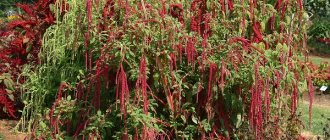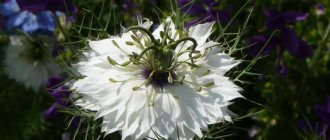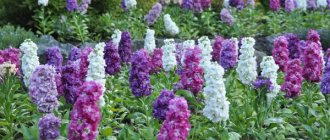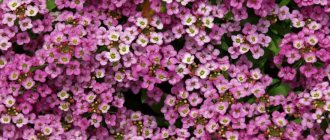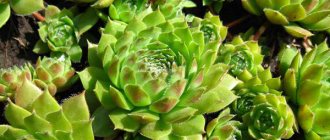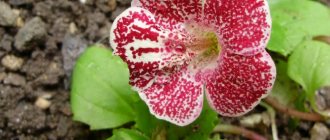Sometimes lovers of flowers, greenery and everything beautiful in their own area advise each other to plant castor beans. And here you can hear the following question: “Castor bean? What is this?". Let's find out what kind of exotic beauty this is, where it grows and what beneficial properties it has. It is quite possible that you will also want to see it on your site.
There are several types of castor beans
From a botany perspective: is castor bean a poisonous plant?
Why did this annual plant of the Euphorbiaceae family receive such a name? The shape of the seeds is similar to the oriental mite, in Latin “ricinuc” - mite. The plant has one large, hollow, erect trunk; numerous branches are crowned with single, large, star-shaped leaves. The leaves can reach 80 cm in length and have pointed edges.
The height of the beauty in Russian temperate climates rarely exceeds three meters, although in the tropics it easily grows to 10 m. In summer, the crown of such a tree is crowned with bright green or red inflorescences with small flowers of cream shades.
Castor bean fruits
The fruits that appear soon are rounded boxes, very similar to prickly balls about 3 cm in diameter. Among the foliage, such spherical boxes look very impressive. The fruits are harvested up to 4 times per season to obtain castor oil.
Castor bean seeds
In autumn, oval-shaped seeds in a smooth shiny shell ripen. The photo shows that castor bean seeds look like mites.
ATTENTION!
The castor bean plant is considered completely poisonous, although the main concentration of the toxic substance is in the seeds.
Application
Castor bean has many uses, as an ornamental plant, in medicine, cosmetology, and industry.
In the garden
The plant is cultivated all over the world for ornamental purposes, mainly due to its beautiful appearance, large and healthy-looking leaves, lush growth and beautiful fruits. If we are aware of the dangers of a poisonous plant (we take precautions) and properly care for it, the tick bean can become an extremely attractive and interesting decorative element in the garden. You just need to remember to care for the plant with protective gloves and not grow it in gardens where children play or there are pets.
Thanks to its large size and attractive bush shape, castor bean looks beautiful in the garden, like a tapeworm against the background of a lawn or a white wall of a building. Its coarse-textured leaves create a sharp textural contrast when placed next to plants with smaller leaves.
It can also be used to create lines along fences and sidewalks or hedges, covering unattractive elements of garden architecture (tool shed, composter) or to divide the garden into zones. One or more specimens of this plant can highlight a driveway or entrance to a home.
Castor beans look beautiful in compositions with:
- rudbeckia,
- perennial asters,
- echinacea,
- cosmoea doubly pinnate.
In the garden, the species is used as a natural remedy for moles and voles.
Castor beans can be grown in a spacious pot on the balcony or terrace.
In medicine, cosmetology
Castor bean seeds are used - Semen Ricini. Castor oil is made from them - Oleum Ricini. The seeds contain 35-58% fat, as well as about 20% protein and toxic compounds - the alkaloid ricinin and the protein ricin.
Castor oil used in medicine differs from technical castor oil; it is obtained from seeds by squeezing or boiling with water. It is characterized by high density and viscosity. Castor oil irritates the mucous membrane of the small intestine, stimulating peristalsis, and therefore has a laxative effect. Castor oil, which is part of ointments and pastes, is a remedy for the treatment of skin ulcers, burns, cutaneous leishmaniasis, diseases of the vagina and cervix, and in ophthalmology.
In cosmetology, perfumery and the cosmetics industry, castor oil is added to lotions and shampoos.
Castor bean is a highly poisonous plant. The main reason for its negligible use is the allergens found in the seeds and chemicals that are toxic to humans and animals, which take a few hours to activate. Ricin contained in the plant irritates the gastrointestinal tract, mucous membranes of the oral cavity, and can damage the kidneys and liver. For poisoning, taking 1-2 seeds is enough; the first symptoms are redness, bloody petechiae on the skin and diarrhea. This is a lethal dose for children.
Industrial use
Thermal pressing of seeds produces up to 60% non-drying oil, from which technical oil is obtained after dehydrogenation.
The oil is used in industry. In its unprocessed state, it is used in mechanical engineering, leather, textile industries, for the production of lubricants, resins, and artificial hides. After technical processing, paints and synthetic fabrics, such as nylon, are made from it. The stems of castor beans can be used to make paper. In some countries, castor oil is also used for home lighting.
Castor bean: varieties in the garden and places of growth
Uncontrollably interbreeding, castor beans today have somewhat diversified their appearance. According to botanical information, it is customary to call all varieties “common castor bean.” However, it has several forms.
Varieties and photos of the castor bean plant
| Photo | Name | Peculiarity |
| Ordinary | The height does not exceed 1.5 m, the stem is green, the foliage is glossy. | |
| Borbonskaya | Tree-like red trunk, height - 3 m, leaves are very large. | |
| Zanzibar | Reaches 2 m, the largest leaves of all castor beans. Color: dark red. | |
| Indian | Height - 1.2 m. The trunk is black-green, the foliage is dark green. | |
| Gibson | Grows up to 1.5 m. Both the trunk and leaves are dark red. |
Today, this plant is gaining popularity not only due to its decorative qualities, but also as a medical and technical product. The plant is widespread on all continents except Antarctica, as well as in Asia, the Caucasus, Ukraine and the Middle and Lower Volga region.
Choosing a planting site, soil requirements
In the right position, the plant grows very quickly and can reach 1.5-2.5 m in height during the season, so you should allocate enough space for it.
Castor beans grow best in soil:
- wet;
- well drained;
- fertile;
- with pH from 5 to 6.5.
Grows best in well-drained, moist sandy loam. However, it also tolerates semi-dry, infertile, acidic or alkaline soils. The plant copes with poor soils, but grows slower, blooms less, and bears fruit.
For proper growth, the plant needs a sunny, warm, protected, secluded place. In such places it will develop harmoniously, its color will be expressive. However, castor beans do not tolerate full shade or frost. In open, windy places, the plant must be supported with supports to avoid breaking the stems.
Features of growing castor beans: planting and care in open ground
We remember that castor beans do not like frost and shading, so we choose the sunniest place for planting. To know when to plant, we select the planting time taking into account return frosts in your area: the further south you go, the fewer problems there are with growing from seeds.
ADVICE FOR THE VOLGA REGION!
Castor beans can also be grown without seedlings. To do this, the seeds must be soaked in advance in a damp cloth in mid-May, and planted immediately in the ground in a permanent place. It is optimal to throw 2-3 seeds into the hole, dig in and cover with a transparent film until shoots appear.
But you still need to remember that this southern woman comes from Africa. Therefore, we select convenient conditions for it: loose and nutritious soil should always be moistened. If you plant in seedlings, then drop one seed into one container to a depth of 2 cm.
Shoots appear quickly. It is better to remove the oily peel from the cotyledon leaves by first moistening it. This will prevent the plant from rotting.
After the final frosts have passed, the plants begin to be taken outside for hardening. You should not immediately plant all the seedlings in a permanent place. Give the southern beauty a week to get used to other conditions, and then use the transshipment method to plant it in a sunny area.
Castor bean is a heat-loving plant
Sowing seeds for seedlings
Typically, castor bean seeds remain viable for 2-3 years. You should not sow seeds directly into the ground; the plants may not have time to bloom, since they have a long growing season and are heat-loving.
When to sow castor bean seeds? Seeds should be sown in March, otherwise they may not have time to bloom and bear fruit.
It is better to sow castor bean seeds in March-April in greenhouses or in pots filled with fertile, humus substrate. It is better to plant seeds soaked for a day one at a time and keep the pots in a warm place, which will speed up their germination.
Advice. The germination of castor bean seeds is very uneven, the difference between the first and last ones can be up to a month. To improve even germination, rub the hard seed skins between two pieces of fine sandpaper and then soak at least overnight.
The ideal temperature range for seed germination is 10-18 °C, and 20-26 °C is the average daily temperature range for normal growth.
After germination, transfer the seedlings to a sunny position. The seedlings grow very quickly. Since there is still little sunlight in March, the seedlings become very elongated, and we get two cotyledons on a very long stalk. You can plant the seedlings in separate deeper pots, thus shortening the stem and burying it in the ground. Also, when planting in the ground, you can plant the seedlings deeper than they grew in the pot.
Water the crops as needed. Young seedlings are sensitive to too high soil moisture, which leads to root rot.
Simple rules for caring for castor beans
Experienced flower growers and gardeners have already figured out all the nuances of caring for a flower that looks like a palm tree, and have put all the rules together:
- Abundant and regular watering.
- Frequent weeding, especially during the period after germination.
- Fertilizing with mineral fertilizers containing nitrogen is mandatory in the first half of summer.
All work with the plant is carried out with gloves. After completing all manipulations, you must immediately wash your hands with soap!
Thus, we see that caring for such a garden miracle couldn’t be easier.
The plant is unpretentious in care
Castor bean: palm tree for northern latitudes
Castor bean is a tall, powerful plant, with its spreading leaves reminiscent of a palm tree. Castor beans are grown to shade a recreation area, in a flower garden or alone, lined with low annuals. Despite the fact that these “palm trees” are warm and sun-loving, they grow in any summer in almost any climate, if you approach the matter the way FORUMHOUSE users do.
Castor beans can be successfully sown (if this word is applicable here, castor bean seeds are large and similar to beans) directly into open ground if you live in Ukraine or the Rostov region of Russia. It is not in the south of our continent that castor beans grow well, bloom and even ripen, but if they are grown in seedlings.
Seed preparation
The shell of castor bean seeds is very strong, and for better germination it is recommended to break it. You can carefully cut through each seed with a nail file or open each seed with a needle. However, many users of our portal believe that it is enough to simply soak a seed for a day or three in warm water (40 degrees), this is enough to understand which seeds will be useful.
DreamerFORUMHOUSE user
If the seed is good and strong, then no manipulations with filing, scratching, biting, gnawing, etc. are necessary. It is enough to first soak it in a cloth and plant it in the ground, without even waiting for it to peck.
The dreamer has been growing castor beans for eight years and has never subjected the seed to mechanical processing.
There is no need to soak the seeds for longer than three days: if you keep them in a humid environment, they may rot.
Soaking does not mean drowning in water, but placing it in a damp cloth.
Plant the prepared seed in moist soil, cover it a little with soil, and cover it with a bag on top.
SkisaForumHouse User
It is convenient to grow castor beans in two-liter plastic bottles with the top cut off. I fill the soil up to about halfway and add more soil as I stretch it out. Then it is very convenient to transport it to the dacha. Just don't forget to make holes in the bottom.
The castor bean grows in an unusual way: thick loops appear, which then straighten out.
Sowing time
Quite often, overwhelmed by the desire to grow a huge palm tree, gardeners sow seeds for seedlings at the end of February. This is a mistake; you shouldn’t do this, especially if you live in a region where recurrent late-spring frosts are not uncommon. Castor beans are planted in exhaust zones only when the threat of these frosts is guaranteed to have passed. In most regions this is June. If you sow the seeds early, the seedlings will stretch out by this time. And seedlings planted at the end of March - beginning of April grow to 30-40 centimeters.
Castor beans sown for seedlings in February will bloom later than in March.
Castor beans are planted in prepared soil, which is well loosened and fertilized. In order not to injure the root system during planting, castor seedlings are thoroughly watered, then the lump of earth becomes compacted and the roots do not “cling” to the pot in which they were sitting.
Plant the castor bean in a sunny place - this is the only way the red castor bean will be truly red. In general, the more sun and heat this plant receives, the better it will feel. Castor beans that grow in partial shade will always be inferior to those that grow in the sun.
All castor oil care comes down to timely watering and, if desired, fertilizing with nitrogen-containing fertilizers. When planting in exhaust gas, you can add a little wood ash into the hole. Castor bean loves well-drained soils, and if groundwater is close to the site, this affects its growth rate and overall health.
Lazy summer resident LenaForumhouse user
If there is close to water, then it grows poorly and hardly turns red.
It is not always possible to see the castor bean flowering - this is not a problem, its leaves are quite decorative: huge, of different shades, depending on the variety.
A dreamer who loves castor beans for their ability to create Turkey in the Moscow region, plants different varieties. Let's see how this “palm tree” grows in the Moscow region climate.
Zanzibarkaya : fast-growing, tall and extremely unpretentious variety.
Northern palm. The height and color of the leaves declared by the manufacturer did not fully appear. The dreamer believes that this was influenced by the lack of sun and water.
Gibson: stocky variety, robust palm.
Oracle: the most capricious of all four varieties: it sprouted later than everyone else, grew slower than others and grew to a rather modest size. But the color of the leaves was beyond praise, and the ability of the leaf to change shade depending on age and lighting was fascinating. In general, this game is worth the candle.
And, of course, the blooming castor bean looks impressive. This is a plant that you want to show off to your guests and neighbors. A reputable florist on our portal Nimfea advises planting castor beans either in the background of the flower garden, or in solitary groups of 3-5 roots, the distance between plants is a meter and a half.
NimfeaFORUMHOUSE user
I also planted one at a time with a padding of short summer plants.
But all this beauty is for one season. Sometimes it is not easy for summer residents to come to terms with the annual nature of castor beans; there is a temptation to somehow preserve or propagate it, to keep it at home in a tub until next spring. But it is better to stick to agricultural techniques that have been proven over the years.
ChigsaAdministrator FORUMHOUSE
Dry air will not benefit castor beans. And then - this is not a small plant, even if it survives, how can we send it to the dacha in the spring? Carry it in your arms?
Our video will help you create a flower garden on your property. Our article will help you choose roses that look great next to castor beans. And join the discussion of agricultural technology and castor bean varieties on FORUMHOUSE.
The benefits and harms of castor beans
Let's compare the beneficial properties of the plant and its harmful qualities.
| Benefit | Harm |
| Useful composition of seeds: up to 60% fatty oil (castor). | The toxic substance is ricin, despite all the processing, some of the poison remains. Ricin has an inhibitory effect on protein biosynthesis at the ribosome level. |
|
The benefits significantly outweigh the toxic qualities of the plant.
How dangerous is castor bean?
Castor bean seeds contain a record amount of fatty acids, but they also contain toxic substances, in particular ricin. This is a dangerous natural poison that, if accidentally swallowed, causes gastrointestinal bleeding, vomiting, and painful abdominal cramps.
Along with problems in the functioning of the digestive system, the water and electrolyte balance is disturbed. Without timely medical care, death of a person or animal occurs within 6-8 days.
With emergency medical care, it is possible to save the life of a poisoned person. But it is impossible to completely restore the normal functioning of the affected organs. Ricin instantly destroys protein compounds in tissues and has no antidote.
Castor oil can only be used on the recommendation of a doctor. This remedy is prescribed exclusively for a short period of time, since its long-term use leads to loss of appetite, nausea and disturbances in the digestive tract.
Indications and contraindications for use
Medicinal uses of castor beans: laxative, wound healing effect, anti-inflammatory agent.
You should not experience an overdose of castor-based medicines. They say castor bean seeds can easily kill a horse. The author of the article did not check this personally, however, we consider it necessary to warn readers against consuming the seeds of the plant internally. There is no antidote for castor bean poison; it is stronger than potassium cyanide.
REMEMBER!
If you accidentally swallow even a single seed of a plant, you should immediately induce vomiting and make sure that the seed comes out!
Excess castor oil causes stomach upset. Castor bean products are contraindicated during pregnancy and lactating women. In these cases, it is better to ask your doctor for recommendations.
Castor oil must be used with caution
Sprouts
Seedlings should appear 3-4 days after planting. Moreover, if the leaves do not have enough strength to free themselves from the seed skin, they will have to help by removing the sticky layer with tweezers.
The emerging shoots develop quite quickly. The best conditions will be provided by a well-lit, cool place (but with a temperature not lower than 15 degrees). As the palm tree grows, garden soil is carefully poured into the pot.
If the castor bean grows very quickly, you will have to carefully move the plant to a larger container.
As the castor plant grows, they begin to gradually harden it, accustoming it to less favorable living conditions.
Where and how to use castor beans
The use of castor oil everywhere: treatment of gastrointestinal inflammation, help with colitis and fever. Castor oil is used externally to remove warts and whiten age spots.
Eyelashes become thicker and longer if you regularly lubricate them at night with castor oil.
In medicine, the oil of this plant helps in the field of gynecology: stimulating the contractile activity of the uterus. An infusion from the plant helps treat gynecological inflammation, colds, and bronchitis.
Review of diseases and pests
It is rare that castor beans are attacked by pests, because it is a poisonous plant. However, there are still several individuals that can damage it: wireworms, winter caterpillars and cotton bollworms. To combat them, use all kinds of insecticides that have a wide range of effects.
The plant is also susceptible to gray rot, sclerocinia and fusarium. If you do not want the plant to be damaged by them, you need to purchase seeds from a specialized store. Do not plant castor beans in one place more than once every 8 years. The drug Granozam also fights diseases well.
Photos of castor beans in landscape design: tips
When choosing a variety of southern settlement to plant on your site, you should pay attention to the combination of the tree with other flowers. It is better to set off green forms of the plant with variegated flowers, and red varieties with their red-violet foliage combine effectively with large rose bushes.
Such a beauty will get lost among other tall plants, such as astilbe, dahlias, and lilies. It is best to place the plant in the center of the flower bed, focusing on its growth and leaf size. But then you will have to choose neighbors in the flowerbed who will like some shading from the gorgeous castor bean foliage. Trees that look so much like a palm tree can be planted in a bunch, the spreading nature of the bush is extraordinary!
Here are examples of placing castor bean plants in different photos:
An example of placing castor beans in landscape design
Using castor beans you can create a path in the garden
Varieties
Castor bean varieties differ in growth and color of leaves and flowers:
- The variety "Carmencita" Carmencita has dark green leaves, intense red flower buds and seed pods.
- Castor bean "Gibson" Gibsonii is distinguished by purple-red leaves with a metallic sheen.
- "Zanzibar" Zanzibarensis - characterized by leaves covered with a network of white veins.
- The Impala variety is widely chosen by gardeners. It has multi-colored leaves - the lower ones are brown-green, the ones above are brown-red and creamy-yellow flowers. The fruit capsules resemble chestnuts in appearance.
- "Sanguineus" Sanguineus - with reddish leaves.
The many varieties of castor beans allow many plant lovers to find a suitable option in terms of color or size of the bush and its use in the garden.
At what price can you buy castor bean seeds?
Castor bean seeds can be purchased both in online stores and from retailers. There are always seeds available at large garden centers. Typically, the package indicates the name, photo of an adult plant, sowing dates and growing season.
The cost of a pack of seeds varies from 20 to 60 rubles. Beautiful names are variations of the forms we have already indicated above. When buying seeds, choose in advance what such a tall beauty will be combined with on the site.
We hope that we have answered all your questions, we will be glad to see any additions in reviews and comments!
A little history
The castor bean plant probably came to us from Africa. Although now it can be found in China, Iran, Brazil, Argentina and many other countries.
In Egypt, castor bean seeds are found in tombs built long before our century. So the plant is an old-timer on our planet, but still attracts the admiring glances of the owners of the miracle tree and their guests.
In Russia, the castor plant is better known as castor, Turkish hemp or tree of paradise.
Autumn Rhapsody
An elegant plant with extraordinary leaves and inflorescences. The Autumn Rhapsody variety will create an atmosphere of the sultry south in the garden. It is planted on lawns and flower beds as an accent of the composition, in combination with climbing perennials.
After flowering, castor beans are decorated with capsules of lemon-yellow seeds. Their clusters can reach 60 cm. If desired, you can collect the fruits and dry them. This must be done with gloves.
For seedlings you need to choose a warm and well-lit place with nutritious soil. The soil must always be moderately moist, otherwise the tropical guest will not show itself in all its glory. After planting, it is advisable to feed the bushes several times with complex fertilizers.
